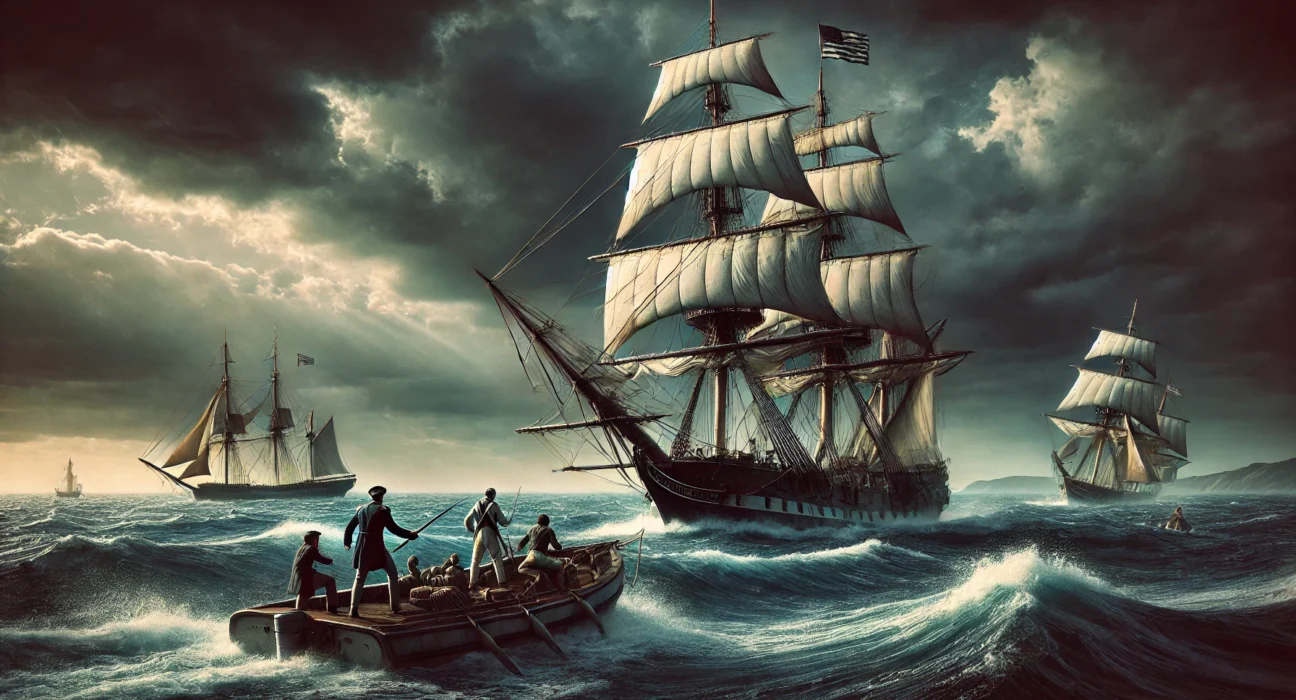The Capture of a Slaver, written by John Taylor Wood and published in 1900, is a historical account detailing the United States Navy’s involvement in the suppression of the transatlantic slave trade. Wood, a Confederate naval officer and descendant of prominent U.S. figures, narrates his experience as a midshipman on the brig Porpoise during a mission off the West African coast. The story revolves around the harrowing capture of a slaver, vividly portraying the brutality of the slave trade and the Navy’s role in enforcing anti-slavery laws during the early 19th century.
Plot Summary
Under the intense sun of the African coast, the Porpoise, a U.S. naval brig, sailed cautiously, tasked with intercepting ships involved in the illegal slave trade. The year was 1850, and the brutal traffic in human lives was flourishing despite efforts by nations to abolish it. The Porpoise was one of many ships patrolling these waters, often frustrated by the speed and cunning of the slavers. The vessel itself was slow and cumbersome, armed with ten guns but hardly fit for the chase. Yet, under the command of Captain Thompson, the crew remained vigilant, hoping for a fortunate break.
Word reached the Porpoise that slavers were lurking along the Bonny and Cameroons rivers, hiding in the maze of waterways until the coast was clear to slip out with their human cargo. Alongside their faster consort, the British schooner Bright, the Porpoise set a trap. They feigned departure, heading south under the cover of night, only to double back in the early morning, positioning themselves where any ship attempting to flee would have no escape. At dawn, the horizon revealed their quarry—a brigantine, sleek and fast, its sails full of the land breeze, racing westward toward freedom.
The chase began in earnest. The Porpoise gave pursuit, every sail unfurled in the hope of closing the distance before the sea breeze filled the slaver’s sails. For hours, the brigantine outpaced its pursuers, disappearing into the horizon as the Porpoise struggled to maintain speed. A calm descended upon the sea, frustrating the chase. The sun bore down mercilessly on the crew, who could do little but wait for the wind to return. At last, the breeze began to stir, and hope returned. The Porpoise regained speed, slowly but surely shortening the gap.
As the slaver felt the wind once more, it hoisted every possible sail, striving to outrun its fate. But the Porpoise, aided by the strengthening sea breeze, was determined. The gap closed. Orders were given to prepare the long-range guns. The first cannon shot boomed across the water, missing its mark but signaling the beginning of the end for the slaver. With each successive shot, the aim improved. Finally, a lucky shot severed the slaver’s peak halyards, bringing down its gaff-topsail. The crew of the Porpoise cheered as the slaver’s speed faltered. The brigantine was crippled.
The slaver, still defiant, made one last attempt to escape, cutting loose its studding sails and executing a daring maneuver to cross the Porpoise’s bow. But it was too late. The American brig had anticipated the move and adjusted course to cut off any retreat. The distance between the two ships dwindled until the slaver could no longer evade capture. Its captain, a burly, defiant Spaniard, hoisted the Spanish flag, refusing to surrender until the very end.
When the Porpoise came within range for boarding, Lieutenant Bukett led a team to seize the vessel. As the boarding party climbed aboard, the Spaniard raged, hurling insults and accusations, protesting the attack on what he claimed was a legitimate trader. His defiance quickly turned to violence when he attempted to retreat below deck. A fierce struggle ensued as he fought off the crew, nearly overpowering them with his strength. It was only after a desperate fight that he was subdued, shackled, and brought aboard the Porpoise as a prisoner.
As the smoke cleared and the prize was secured, the crew of the Porpoise discovered the horrors that lay below deck. Hundreds of enslaved Africans, packed tightly in the stifling hold, lay gasping for air, their bodies twisted and battered by the conditions of their confinement. The stench of death and suffering rose from the vessel as the crew worked frantically to bring the survivors on deck. Some had already succumbed to the squalid conditions, while others hovered on the brink of death, their bodies too weak to endure much longer.
Captain Thompson, moved by the scene, ordered immediate relief. Water and food were brought to the suffering captives, and the ship’s doctor worked tirelessly to revive those near death. But despite their efforts, seventeen lives could not be saved, and their bodies were committed to the sea. The surviving captives, men, women, and children, slowly regained some semblance of life as they were allowed to breathe fresh air and bask in the sunlight on the deck.
With the slaver now under the control of the Porpoise, Captain Thompson ordered that it be sailed to Monrovia, Liberia, to deliver the captives to freedom. The journey was fraught with tension. The crew of the Porpoise was small, and with nearly 350 prisoners aboard, any hint of unrest could spell disaster. The enslaved, though weak and traumatized, posed little threat, their spirits crushed by months of suffering. Still, the crew remained on high alert, armed and ready for any sign of trouble.
The slaver’s cargo, once a valuable commodity destined for the markets of Brazil or Cuba, was now a solemn responsibility. The captives were treated with care, allowed to stay on deck during the day, and given what little comfort the ship could provide. Their condition slowly improved, but their future remained uncertain.
After weeks at sea, the coastline of Liberia appeared on the horizon. Monrovia, the capital of the fledgling colony established by freed American slaves, offered a tenuous refuge. However, upon arrival, local officials refused to allow the captives to land, citing concerns about their ability to integrate into the community. Undeterred, Captain Thompson pressed on, sailing further along the coast to Grand Bassa, where the Liberian governor reluctantly agreed to accept the captives.
Even at this final stage, the local king, a powerful figure in the region, demanded payment in exchange for allowing the Africans to land. Captain Thompson refused his demands, threatening consequences if any harm befell the captives. Eventually, a tenuous agreement was reached, and the prisoners were unloaded. Yet as they were left on the beach, surrounded by curious natives, the fate of the freed Africans remained uncertain. Far from their homeland, they faced an unknown future in a foreign land.
The Porpoise weighed anchor and sailed for Porto Praya, her mission complete. The captured slaver now lay empty, but the human cost of the voyage weighed heavily on the crew. As the ship faded into the horizon, the story of the Porpoise’s pursuit and capture of a slaver was etched into the annals of history, a grim reminder of the horrors of the slave trade and the relentless fight to end it.
Main Characters
John Taylor Wood (Narrator): The central figure of the story, Wood serves as a midshipman aboard the Porpoise during its anti-slavery patrols. His perspective as a young officer shapes much of the narrative. Though dutiful and resourceful, Wood grapples with the moral complexities of the slave trade, balancing professionalism with compassion for the captives.
Captain Thompson: The commanding officer of the Porpoise, Thompson is portrayed as a competent leader, tactically guiding the ship through its chase and capture of the slaver. His firm but compassionate nature is reflected in his humane treatment of the enslaved Africans after the capture.
The Spanish Captain (of the Slaver): The antagonist, the Spanish captain is a defiant and dangerous figure who violently resists arrest. His determination to escape, even at the risk of his crew and the enslaved people on board, paints him as a callous and self-serving individual.
Theme
The Brutality of the Slave Trade: One of the dominant themes in the narrative is the inhumanity of the transatlantic slave trade. Wood’s detailed descriptions of the cramped, diseased, and suffering enslaved people highlight the appalling conditions they endured. This serves as a critique of the moral corruption inherent in the trade.
Duty vs. Morality: Wood and his fellow officers are bound by their duty to enforce anti-slavery laws, yet they often face moral dilemmas when confronting the consequences of their actions. The narrative explores the tension between fulfilling military orders and the moral imperative to alleviate human suffering.
Human Suffering and Resilience: The enslaved Africans are depicted as silent sufferers, enduring unimaginable hardships. Despite their physical and emotional torment, many display resilience, which Wood acknowledges. The contrast between their docility and the horrific abuse they face evokes deep empathy from the reader.
The Role of the Navy in Law Enforcement: Wood emphasizes the Navy’s responsibility in upholding international law and its involvement in suppressing the slave trade. The narrative highlights the strategic challenges faced by naval officers in capturing slavers, emphasizing the Navy’s role as both a law enforcement and humanitarian entity.
Writing Style and Tone
John Taylor Wood employs a factual yet deeply reflective narrative style. The story is written in the first person, providing an intimate and personal account of the events. Wood’s descriptions are vivid, bringing to life the harrowing chase, the violent resistance from the slaver’s captain, and the horrific conditions of the enslaved. His use of nautical terminology and precise details grounds the narrative in the practical realities of 19th-century naval warfare and life at sea.
The tone of the work is a blend of stoic professionalism and underlying moral reflection. Wood maintains a measured and duty-focused demeanor in recounting the ship’s operations, yet moments of introspection reveal his deep discomfort with the horrors of the slave trade. His writing, while formal, is interspersed with moments of empathy, particularly when describing the enslaved individuals. These passages contrast with the tense, action-filled scenes of naval pursuit and capture, creating a balance between the human and military aspects of the narrative.
We hope this summary has sparked your interest and would appreciate you following Celsius 233 on social media:
There’s a treasure trove of other fascinating book summaries waiting for you. Check out our collection of stories that inspire, thrill, and provoke thought, just like this one by checking out the Book Shelf or the Library
Remember, while our summaries capture the essence, they can never replace the full experience of reading the book. If this summary intrigued you, consider diving into the complete story – buy the book and immerse yourself in the author’s original work.
If you want to request a book summary, click here.
When Saurabh is not working/watching football/reading books/traveling, you can reach him via Twitter/X, LinkedIn, or Threads
Restart reading!








